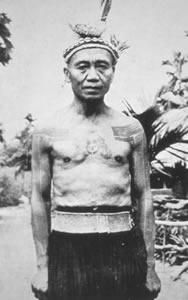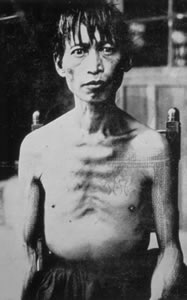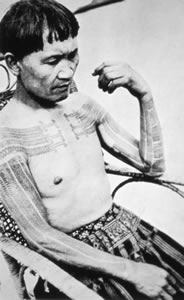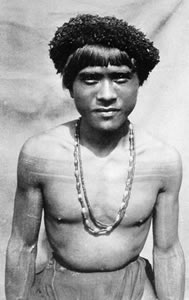LOOSING YOUR HEAD AMONG THE TATTOOED HEADHUNTERS OF TAIWAN
| |
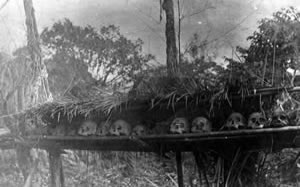 |
| |
Atayal skull rack, ca. 1900. |
Article © 2005 Lars Krutak
Taiwan, formerly known as Ilha Formosa (Portuguese for 'beautiful island'), is a mountainous island lying approximately one hundred miles south of Mainland China. Today perhaps less than two percent of the total population is indigenous occupying the central mountainous region, the coastal plains, and a large portion of the southeastern hill country. Traditionally, twelve, or more than one half, of the aboriginal tribes practiced tattooing. They included both plains and mountain tribes.
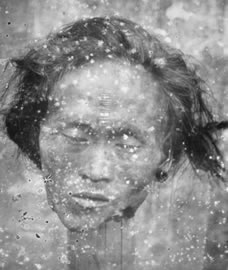 |
|
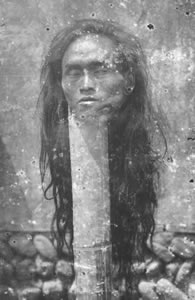 |
|
|
Atayal headhunter trophies. |
|
The earliest account of the tattooing custom was given in the History of the Sui Dynasty, dating to the 7th century (A.D. 607). But with the coming of outsiders in the 17th century (Dutch, Spaniards, Chinese, and later Japanese), tattoo rapidly lost its traditional meaning and began to disappear altogether. By the terminal period of the Ch'ing Dynasty (1644-1911), tattoo was extinct among the coastal tribes and by 1914, under order of the ruling Japanese, tattoo became rare among the mountain peoples. By 1950, only traces of the indelible art remained.
Aboriginal Formosans lived in all districts of Taiwan until
large in-migrations of Han Chinese forced the 'barbarian tribes' to
withdraw into the central mountains about 300 years ago. This trend
towards isolation continued throughout the fifty years of Japanese
colonial rule (1895-1945) when indigenous peoples still remained
relatively undisturbed from Western contact. However, by the beginning
of the 20th century, the indigenous strongholds of the Atayal, Paiwan,
Saiset, Bunun, Rukai and other 'tattooed tribes' were threatened by the
expanding camphor industry that increased the flow of outsiders and
contributed to widespread rebellion and bloodshed.
Growing in immense stands in the Central Mountains of Taiwan,
slow-growing camphor trees were utilized in ship building and in the
manufacture of mothballs, perfumes, and more importantly celluloid: a
material that could be used to make medicines, combs, tobacco pouches,
and billiard balls. Since the method of collecting camphor necessitated
the clear-cutting of the forest, encounters with indigenous Taiwanese
increased forcing the Japanese to take-up defensive measures to protect
their economic interests. Expanding on the Chinese defensive system of
aiyu-sen, or guard-line, the Japanese basically encircled the
indigenous territories with military outposts connected by battle fences
that were constantly being advanced as the Japanese conquered new
camphor groves. Harry Franck, an American writer who traveled to Taiwan
in the 1920s, described the aiyu-sen as follows:
The aiyu-sen, or guard-line, is a cleared
space, from fifty to a hundred feet wide,
climbing over hill and dale completely
around the uncontrolled territory. It is
started by cutting a road along the crest of
a mountain, then destroying the
vegetation on either side of this far
enough back so that the guards can see
attacking savages in time to defend
themselves. This system dates back to
the reign of Ch'ien-Lung, toward the
middle of the eighteenth century, when
the Chinese paid tamed savages to
protect them against the others.
…The Japanese have constructed bulletproof,
loopholed forts, barbed-wire
entanglements, mines, and wire fences,
the latter in some places locally electrified
by harnessing mountain streams; handgrenades,
sometimes mountain-and fieldguns,
are used; on the east coast warships
have occasionally been called
upon to subdue belligerent villages…
Today the guard-line is about three
hundred miles long.
|
|
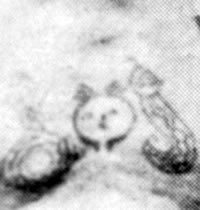 |
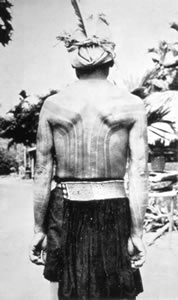 |
|
Paiwan headhunter's tattooing, ca. 1930. Note the tattoo of the 'hundred-pace viper' in the center of the chest flanking the tattoo of a human head. These snakes were symbolically tied to 'the spirit of life, the greatest of all spirits' in Paiwan mythology.
|
Headhunting in Taiwan
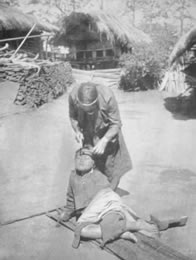 |
|
|
Hammering the tattoo home! An Atayal tattooist at work in 1910. |
Between 1903 and 1908 there were seventy advancements
made to the guard lines by the Japanese, but indigenous men in
search of heads often came over or under the barrier at nightfall
to lay waiting in ambush for unsuspecting victims. Headhunting,
the primary ritual component of the Atayal, Paiwan, Saiset, and
other groups, not only served to maintain the prosperity of
society by ensuring agricultural and community fertility through
the propitiation of the deities and ancestors, it also ensured that
a man would meet with success in finding a wife while at the
same time guaranteeing his safe passage to the afterlife. Thus,
the custom was considered indispensable to life and existence
itself.
Among the Atayal, success met on the headhunt was
deliberately marked upon the chins of warriors with tattoos. And
those headhunters who acquired more than five heads using old
weapons, like a curved machete-like knife, might also have their
chests tattooed or the backs of their hands. Among the Paiwan,
it was believed that the spirits of ancestors dwelled in these
beheading knives, which were held in the possession of the tribe
for several generations. However, the Paiwan were not
necessarily tattooed after having taken a head; instead, the
successful warrior was also denoted by the wearing of a certain
kind of cap which was made by women of the tribe.
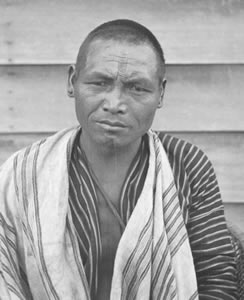 |
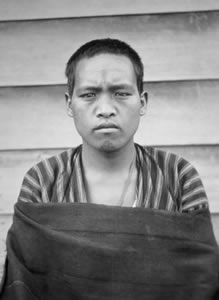 |
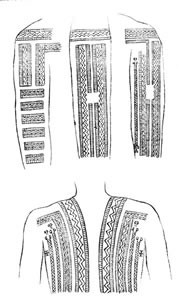 |
|
Atayal headhunters with chin and
forehead markings, ca. 1900. |
Rukai chief and headhunter
tattoos, ca. 1900. |
More generally, tattooing could also be administered to the
foreheads of unmarried Atayal boys and girls in their teens.
Apart from the tattooed foreheads of women, only those who
were skillful in weaving could tattoo their cheeks and other parts
of their bodies.
Besides the beautiful cloths
they wove on the loom,
Atayal women also
manufactured net bags that
headhunting husbands used
to carry severed human
heads. Next to his
beheading knife, these bags
were his most treasured
possession.
It is not surprising, then, that the Atayal believed that only
those women who were proficient in weaving (hence
tattooed), and those men who were successful
headhunters (also tattooed) could pass safely into the
afterlife. Atayal Tattoo Artists
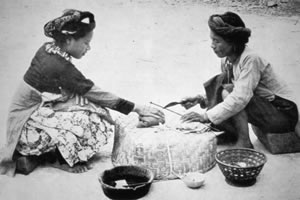
|
|
|
Paiwan tattoo artist at work, ca. 1930. Paiwan tattooists were always shamans and usually women
of high virtue and social standing.
|
|
Atayal tattoo artists, called patasan,
were women. They had to be of high
virtue and most of them inherited their
profession from their mothers, though
some learned it by apprenticeship.
Usually there were not many tattoo
artists in any one particular region, so
if one did not reside in an Atayal
village, one was invited from the
outside. Tattooists commonly charged
a piece of cloth or two strings of beads
for an individual's first tattoo; but, for
one who had married or committed
adultery, she would charge more -
sometimes one or two beaded skirts!
Tattoo artists first stenciled their designs upon the skin with a linen thread soaked in black
soot. The tattoo instrument resembled a toothbrush with four to sixteen needles (atok)
arranged in rows and fastened to a wooden handle about 1.5 cm in diameter and 15 cm in
length. Before iron was introduced to the indigenous Atayal, thorns of orange or tangerine
trees were used. The hammer, which pounded the tattoo instrument into the skin, was called
totsin and was constructed of a single piece of wood about 2.5 cm in diameter and
approximately 17 cm in length. Excess blood was removed with a scraper (quwar) made
from a rattan splint that was bent and bound at either end with linen thread. Lampblack (ihoh)
was used as pigment but occasionally soot from charred pinewood resin was collected, to be
stored in a gourd or small iron case.
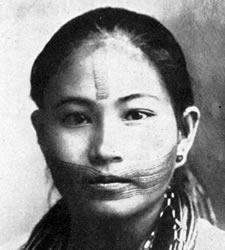
|
Bunun woman with facial
tattooing, ca. 1900. |
Tattooing operations were almost always performed in a small
hut located away from the living quarters and most tattooing
took place in winter, since the cold weather was believed to
facilitate the healing of the tattoos and prevent scabbing.
Interestingly, the Atayal linked scabbing to the lack of virtue of
the client!
The tattoo client lay down with a folded cloth under her head.
The tattoo artist usually sat on a low stool behind her or stood
hunched over the patient with her tool. She took the needle
instrument and knocked it home with several forceful blows of
her hammer and scraped the blood-stained face with the quwar.
Oftentimes a block of wood was held in the tattoo artist's hand,
and with this the tattooing implement was struck after it had
been laid upon the area of application, because this action
ensured a stronger blow and one more accurately placed upon
the forehead. Afterwards the tattooist washed the hammered
area and rubbed it with black soot.
The client prepared herself for the rite
by observing various taboos before the
operation including: no sexual
relations, no drinking of any animal
blood, and especially no wearing of
red-colored clothing, since this was
believed to cause her blood to flow
unabated. The parents of the client
chose a favorable day for the tattooing
by dream divination, and on that
particular day they observed various
bird-omens and offered blood
sacrifices to the spirits of their
ancestors for a safe and successful
operation. Bird omens were also
consulted prior to most ceremonial
occasions and especially before a
hunting or war/headhunting campaign,
because particular birds were in communication with the spirits of ancestors who, in turn,
could guarantee glory in war, health in life, and fertility in agriculture. Vanishing Traditions
| |
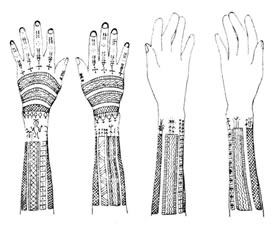 |
| |
Hand and arm tattoos of Paiwan women. |
Unfortunately, the major sociocultural institutions of the Atayal were not to last. Between
1920 and 1935, the Japanese initiated an island-wide program of forced relocation to control
the Taiwanese aborigines and remove them from their ancestral lands: lands which were the
basis of many inherited traditions that shaped social and life experience. For the Atayal, this
trend was particularly disastrous, because their social structure was based upon the principle
of gaya: where all of the descendants of a particular ancestor
worked in common ritual and labor as a social and economic unit.
As family members became dispersed across the country, the
collective structure of the gaya - marked by the sharing of good
luck, disaster, labor, hunting, and prayer - soon collapsed. The
disappearance of many other Atayal traditions soon followed,
such as weaving, headhunting, tattooing, and the communal
ownership of land.
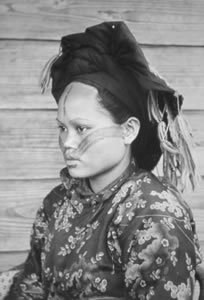 |
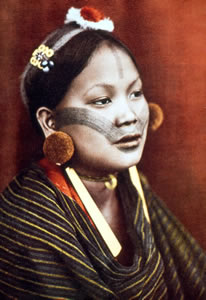 |
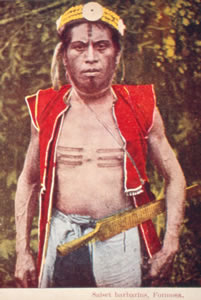 |
|
Atayal weavers with facial tattooing, ca. 1900. |
Saiset headhunter with facial and
chest markings, ca. 1930.
|
Today, the struggle over culture and land rights continues.
Indigenous villages have been relocated by the government
without consent to build dams, airports, and national parks: forests
where it is illegal for indigenous peoples to hunt or fish in their
traditional territories! However, the Taiwanese Council of
Aboriginal Affairs has begun studying the possibility of creating
autonomous regions for aboriginal peoples in several parts of
Taiwan; regions where indigenous peoples (Yuanzhuminzu) will
have an active role in the preservation, sustainability, and
governance of their lands and culture.
Museum photo gallery of these images may
be seen here.
Literature
Formosa Bureau of Aboriginal Affairs
1911 Report of the Control of the Aborigines in Formosa. Taihoku: Bureau of Aboriginal
Affairs.
Franck, Harry A.
1924 Glimpses of Japan and Formosa. New York: The Century Co.
McGovern, Janet M.
1922 Among the Head-hunters of Formosa. London: T. Fisher Unwin, Ltd.
|




